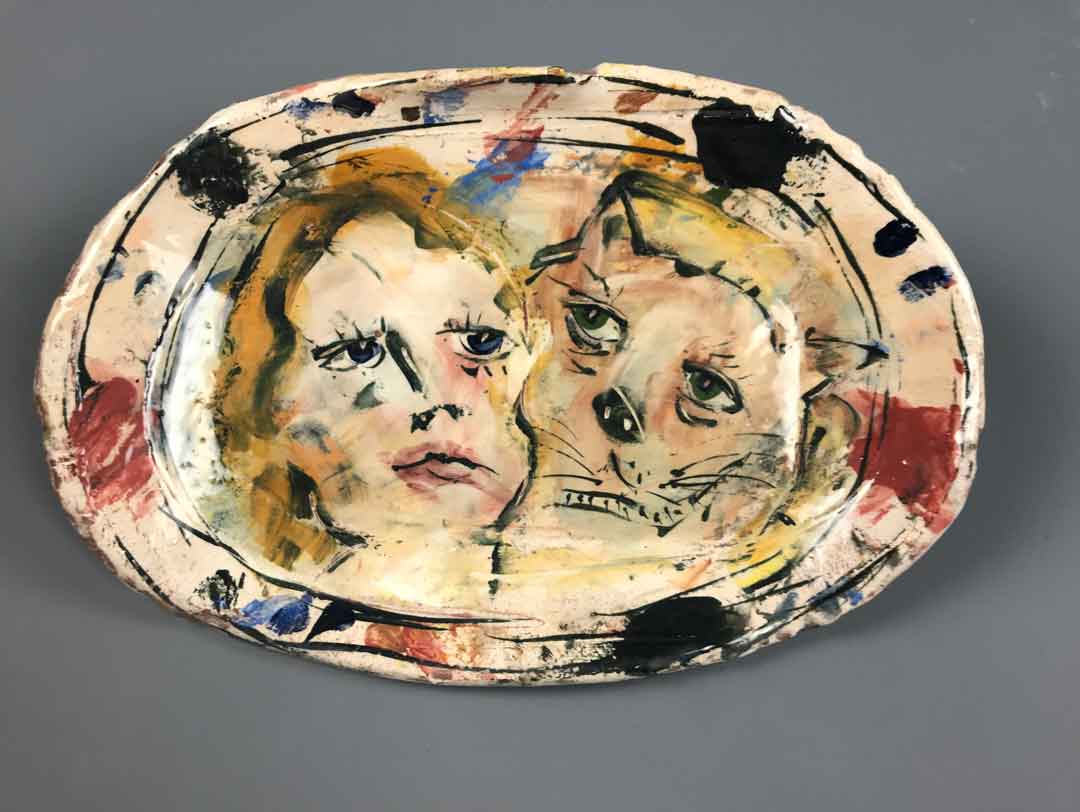 Ron Meyers (American, b. 1934), oval platter with femme and cat, 2009. Earthenware, gas-fired. Georgia Museum of Art, University of Georgia; Gift of the artist. GMOA 2013.240.
Ron Meyers (American, b. 1934), oval platter with femme and cat, 2009. Earthenware, gas-fired. Georgia Museum of Art, University of Georgia; Gift of the artist. GMOA 2013.240.
Ron Meyers’ Work to Go on View at Georgia Museum of Art
We’ll be installing a display of Ron Meyers’ pottery in one of our wall cases this month. Annelies Mondi, our deputy director, selected the works and wrote the text below to contextualize them.
While many of the figures who make an appearance in Meyers’ pottery seem more urbane than untamed, there is a feeling of disquietude and curiosity that arises when viewing a rat smoking a cigar or hog grinning at you from the surface of a plate. Born in Buffalo, New York, Meyers grew up in this industrial, blue-collar city during its heyday. Woven into the fabric of this vibrant city were the values of usefulness, practicality and a strong work ethic — traits that made a lasting impression on Meyers and his work.
As a teenager, Meyers dreamed of becoming a cartoonist; however, at the insistence of his parents, he attended college and received a degree in art education. After graduation, Meyers worked in the local steel plant briefly before becoming an elementary art teacher. He went on to receive a master’s degree in art education and realized his affinity for clay. Meyers decided to pursue this interest and attained a master of fine arts degree from the Rochester Institute of Technology, School for American Craftsmen. It was here, under the tutelage of Frans Wildenhain, where Meyers threw his first vessel on the potter’s wheel. Wildenhain was an explosive personality. Bauhaus-trained, he was an integral leader of the studio pottery movement. This formidable, passionate teacher inspired Meyers and taught him the importance of commitment and how to “live through your art.” A philosophy that Meyers later shared with his own students. After teaching in the art department at the University of South Carolina, Meyers moved to Georgia where he taught ceramics for the next 20 years at the University of Georgia, from which he retired as professor emeritus. Over the course of his teaching career, Meyers became a beloved professor and highly regarded educator.
Early in his career, Meyers primarily worked in stoneware. After a visit to the Royal Ontario Museum in the early 1970s, he was inspired by Japanese ware and its spontaneous, gestural approach and reverence of imperfections. Meyers also incorporated the velvety Shino glaze into many of his works. In the mid-1970s, however, he shifted to earthenware. He had two reasons for doing so. Meyers had long admired the red, earthenware pots used in early English slipware from the 1650s to the 1850s with their bold, free-hand designs and playful motifs. He was also attracted to the pottery of the Mimbres people of the American Southwest from 1000 to 1200 that included images of people and animals on their surfaces. Since his days as a student in New York he had been familiar with the gritty red clay from the banks of the Ocmulgee River near Macon, Georgia, that comprises earthenware. With the oil crisis of 1973, Meyers saw the advantage of using earthenware, which is fired at lower temperatures, thus saving energy.
His work became populated with a cast of characters from femme fatales and wise-guy rabbits to sinister fish and world-weary frogs. With his low-fired, salt-glazed earthenware and wood-fired stoneware of the 1990s and early 21st century, he inscribed his work with expressive marks scratched into the clay. These works are more monochromatic than the bolder colors of earlier work yet convey a rich and candid surface beautifully wedded to the form.
Much of Meyers’ work is functional, wheel-thrown pottery, but he also creates sculptural ceramic forms and drawings. The impulsive, spontaneous quality of his work reveal the evidence of his hand as well as his dry wit. An uncontrollable exuberance and gritty vigor emanate from each pot. With each bold shape and sly smile, a spark of irrepressible abandon and joy is born within the beholder.
